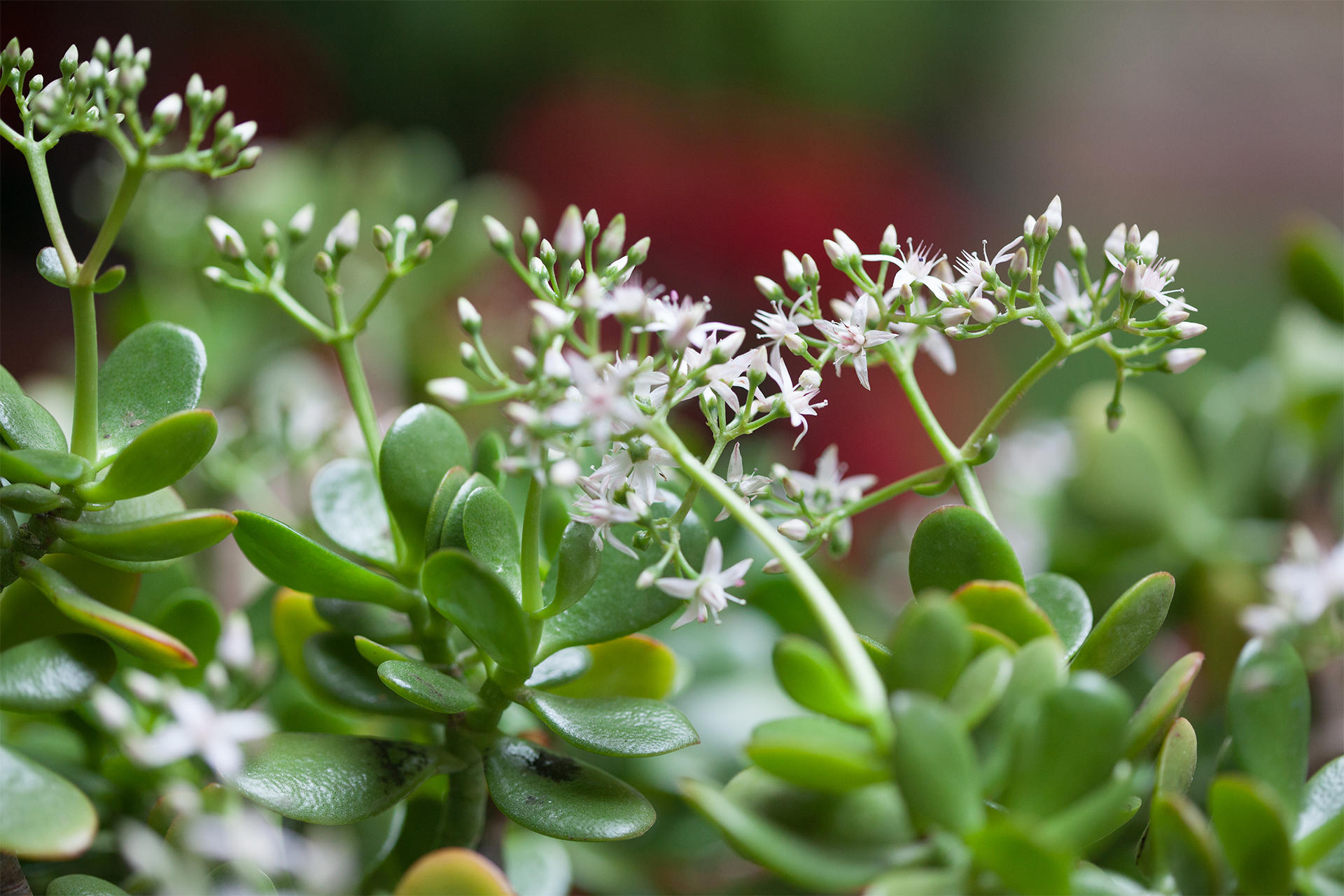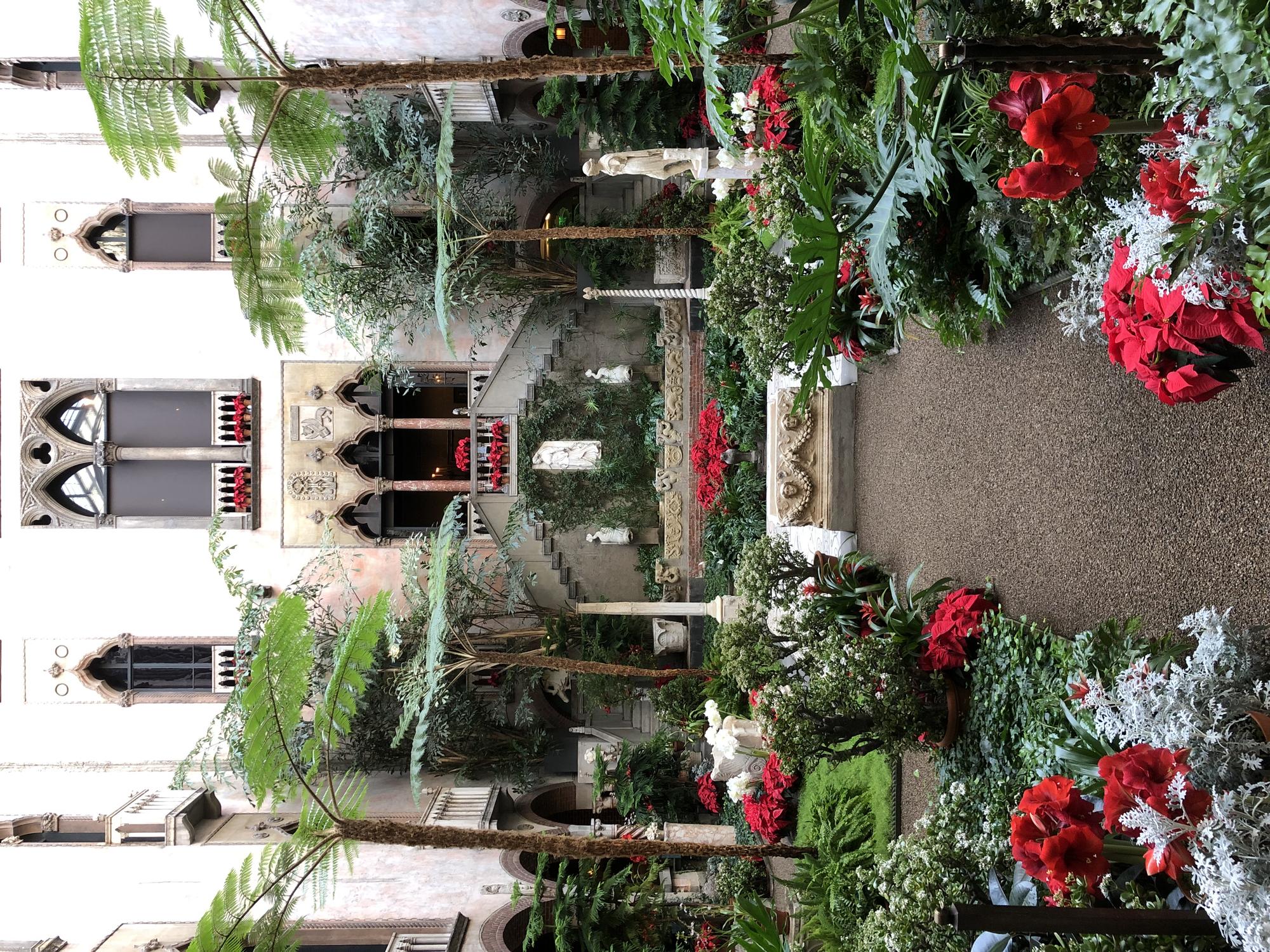When the days grow shorter and the chill of wintertime settles in, the jade plant sets new buds ahead of its festive display in the Courtyard of the Isabella Stewart Gardner Museum. According to legend, the mature jades in the Museum’s living collection—over 60 years old—are descendants of jade plants grown by Isabella herself. This evergreen succulent, though quite a familiar houseplant, is not known by many to flower. By mimicking the growing conditions of its native habitat, Gardner Museum horticulturists coax the jade into yielding airy pink and white flowers just in time for A Holiday Garden Courtyard display.
Photo: Jenny Pore
The History of the Jade Plant
The jade plant (Crassula ovata) is native to the dry, rocky hillsides and Albany thicket valleys of southern Africa. Its smooth, rich green rounded leaves are reminiscent of jade gemstones, earning the plant its common name. The name Crassula—Latin for ‘thick’—alludes to the fleshy nature of its diverse succulent genus. The species name ovata—meaning ‘egg-shaped’—refers to the shape of the leaves. Bark peels from the trunks in horizontal strips. Jade stems appear woody even in young specimens. They twist and turn toward the sun into gnarled shapes, evocative of tree trunks of great age.

New York Botanical Garden, LuEsther T. Mertz Library. https://www.biodiversitylibrary.org/page/4506016#page/116/mode/1up
Mary Emily Eaton (English, 1873–1961), Illustration of Crassula portulacea from New York Botanical Garden’s Addisonia: Colored Illustrations and Popular Descriptions of Plants, vol. 3, Plate 109, New York, 1918
Although Crassula ovata is reported to have toxic effects on both animals and children, jade roots—grated and boiled—are a traditional food source of the Khoisan and other indigenous peoples of southern Africa. With anti-inflammatory and antioxidant properties, jade has long been used in both African and Chinese herbal medicine for skin and stomach-related ailments. Extracts of jade leaves are used to treat wounds, nausea, and diabetes.
Collections of the jade plant crossed oceans and reached botanical gardens with conservatories. Dutch explorers introduced the plant to Europe in the mid 17th century. It thrived in Paris’ Jardin des Plantes, then known as the “Royal Garden of Medicinal Plants.” The jade was first described in England as Cotyledon ovata by Philip Miller in the Gardeners Dictionary of 1768 before being classified as Crassula ovata by English botanist George Druce in 1917. As the jade flourished around the world, its association with prosperity followed.

Photo: Jenny Pore
Variegated jade and Dendrobium orchid in the Courtyard of the Isabella Stewart Gardner Museum, 2022
According to Feng shui—a Chinese traditional practice seeking to bring people into harmony with their surrounding environment—the jade plant gives off nourishing qi or “vital energy." 1 The custom of placing a jade plant inside a home or business to invite prosperity and good luck continues to this day in cultures around the world. 2 The remarkable longevity of the potted jade plant—easily equaling a human lifespan—makes for a priceless living possession. Isabella Stewart Gardner cultivated jade plants in one of her greenhouses at her home Green Hill in Brookline, Massachusetts alongside her impressive collection of bonsai trees.

Isabella Stewart Gardner Museum, Boston (ARC.010334)
Thomas E. Marr (Canadian-American, 1849–1910), Jade Plants in a Greenhouse at Green Hill, the Gardner family home in Brookline, Massachusetts, 1905. Gelatin silver print
The Cultivation of Jade
It’s no wonder the jade plant has been so easily shared around the world. Crassula ovata can be reproduced by simple vegetative propagation. A fallen leaf or broken branch just needs to be dried a few days before being sunken into soil for a new plant to grow. Like other succulent xerophytes, the jade evolved to tolerate desiccation, surviving its arid climate by storing water in its leaves and stems. It also conserves water by employing Crassulacean acid metabolism, or CAM photosynthesis. The jade opens its stomata—pores in the leaves—at night instead of day which allows significantly less water to escape while absorbing carbon dioxide. The stored CO2 can then be used for photosynthesis in the presence of light during the day.

Photo: Jenny Pore
A Holiday Garden display in the Courtyard of the Isabella Stewart Gardner Museum, 2022
The decades-old jades of the Gardner Museum’s living collection spend the summer in full sun at the outdoor growing space of our nursery. When the trees of the surrounding New England forest begin to show brilliant autumnal color, Gardner Museum horticulturists remind the jades of their native arid habitat by further withholding water in order to coax seasonal winter flowering. As cool nights are critical for flower bud formation, the jades stay outdoors until the threat of frost.
Each year, just before Thanksgiving, our royal jades are carefully escorted into Isabella’s Courtyard atrium. When sunlight finds the glossy green leaves, they shine like gemstones amidst a garden of silver and crimson. The end of the year is a time for reflection and gratitude for all things precious.
1 Zoë Sessums, "How Indoor Plants Can Inspire Good Feng Shui," Architectural Digest, 17 January 2020, https://www.architecturaldigest.com/story/how-indoor-plants-can-inspire-good-feng-shui
2 Anjie Cho, “8 Types of Money Plants in Feng Shui,” The Spruce, 12 October 2022, https://www.thespruce.com/get-to-know-the-feng-shui-money-plant-1275013

